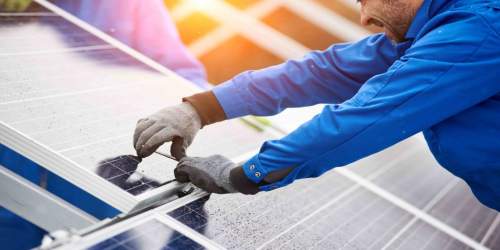Read Time : 4 Minutes
Residential Solar Panels - Return on investment.
It's 2023, are solar panels worth it?
One of the benefits of choosing a renewable energy source such as solar panels to power your home is the prospect of making a profit from it. Not only is this realised in the reduction of your electricity bill because you are producing energy yourself, but you can also sell your excess production to a power company via the Smart Export Gurantee (SEG).
Deciding on what your return on investment will be for residential solar panels depends on a number of factors, not least what it costs you to set up and purchase it but also the quality and standard of the system components that are installed. Your roof size and the direction it faces will dictate the number of panels you can have placed there and the amount of energy you generate, as will the quality of photovoltaic cells used in each panel. Most solar panel installations should last between 20 and 25 years and over with the right maintenance, and the initial cost can normally be off-set within the first 8-12 years. There are many factors to conisder when looking at the payback period for solar panels.
COMPARE PRICES FROM LOCAL INSTALLERS
Compare prices from local companies fast & free
Enter your postcode to compare quotes from leading professionals. We promise to keep your information Safe & Secure. Privacy Policy
The Cost of Residential Solar Panels
The initial cost of an installation will obviously vary depending on the size and quality of panels installed. A small 1 kW system will more than likely set you back between £2-3,000 whilst a larger system of say 4kW (the go-to system size) will be in the region of £6000-8000. Most people who decide to have solar panels will either fund it themselves from savings or take out a loan. There used to be an option to have panels installed for free but the end of government Feed-in Tariff (FiT) saw an end to the rent-a-roof schemes. There are other options to consider such as the ECO4 scheme and the Home Energy Scotland grant but there's much more on that on our Cost of Solar Panels page.
Working out a pay-back period for solar PV installations is tricky. There are many variables - the type of panel and it's efficiency, the orientation of your roof, the way you use electricity, inflation in electricity prices etc. A good installation company company will ask some questions, take a look at your bills abd give you a good idea of your likely savings and pay-back time.
Return on Investment for a 1.25kW Solar Panel Installation
Most solar panel installations will provide a reasonable return on investment when you combine the SEG and energy savings. Obviously, the more energy your system produces and the more of that energy you directly use yourself, the better that investment is, even with the greater cost of installation. A 1.25 kW solar panel installation is perhaps one of the smaller domestic systems you can get and will cost around £3,000. With this size system, the likelihood is the SEG won't play a part. You'll use the electricity the panels generate, at the point of it being generated. Most homes have an idle usage, a fridge, phones etc. It's tough to say what kind of time period you'll be looking at for recovering your initial investment.
Return on Investment for a 2.5kW Solar Panel Installation
Double the size of your solar panel installation and you mostly likely double the savings on your energy bill. The cost of a normal 2.5 kW array will be around £4,000 You may start to see a small payment from the SEG but it would be better to use the electricity yourself as much as possible. You only get 7-15 pence per kW from the SEG and you're likely paying 28-48 pence per kW for electricity from the grid. It often makes sense to install more panels if you have the space. For a 2.5kW system, you still have to have the scaffolding, wiring, inverter etc so sticking a few more panels up whilst your technician is on the roof will shorten your pay-back period. You can often expect a pay-back period of around 10 years.
Return on Investment for a 4kW Solar Panel Installation
If you have the roof space and finance for a large 4kW installation, then you may benefit from even greater returns. The array will cost around £6000 - 8000. This is the point where you could start to factor in the SEG payments and balance it with potential expense of a battery to store the excess energy you produce. If you get a 4kW system installed and are out of the house at work most of the day when the sun is shining, it will often make sense to splash out on a battery, but if you don't want to additional up front cost then you should be able to work out a rough estimate for the SEG payments you will recieve. With all installations, once you have paid off the initial investment then you head into a period of pure profit. With most installations lasting a minimum of 25 years or longer, you will have fifteen years or more where your solar panels are working just for you.
Other Things to Consider
- Generally, the larger your solar panel installation the greater the return on investment for residential properties.
- You don’t normally need planning permission to install solar panels though you will want to check with your local council if you're in a conservation area.
- Solar panels for domestic residences are available in number of different types, such as tiles or straight panels, which may affect the initial cost.
- The cost of energy bills is set to rise again in the next few years so having your own supply may well provide a greater return on investment and save you more money than we have indicated here.
- More and more energy companies are beginning to see independent suppliers as vitally important for maintaining the electricity supplied to the National Grid.
When calculating the total potential savings and income offered by PV panels, it is necessary to consider a wide range of factors, including:
- PV system size, lifespan and efficiency
- Geographical location of your property
- Roof orientation
- Roof inclination
- The amount of shade over your roof (if any)
- Your property's SEG eligibility and/or its Energy Performance Certificate (EPC) rating
- New battery systems are being introduced that will further extend the potential savings past daylight hours
The table below gives you a rough idea of the potential savings and return on initial investment offered by a 3.5kW solar panels system.
|
Cost of 3.5kW system
|
Savings per year*
|
ROI after 20 years**
|
|---|---|---|
|
£7000
|
£600
|
£18,096.27
|
*System output calculated for a rural, inland property in Southwest England. System output for an inland, northern or urban property could be 5%-10% lower.
** Figures shown include a 3.6% per year increase in electricity prices. This is something a lot of installation companies will factor in. Keep in mind that electricity prices increased 54% in April 2022 and 27% in October 2022.
With savings of £600 PA (real value will always vary) and factoring in the 3.6% increase in electricity bills annually, your total savings or ROI would be approximately £18,096.27 over 20 years.
Solar panel system outputs
Depending on your energy consumption, a 4kWp solar panel system producing an estimated 3,600 kWh per annum could therefore in theory produce all of your annual energy needs. However, for an average household, it is unlikely that PV panels will produce all of the required energy; the exact proportion of the household’s energy use produced by solar panels is contingent upon energy consumption habits. With the introduction of new battery storage systems the consumption of the free solar generated electricity can be extended into the night time, furher increasing savings.
Optimise your usage of the electricity generated by your PV system
It is possible to use the excess electricity generated by your PV system to heat water and heat your property during the day, although once again the viability of this option depends on your energy consumption and efficiency. It is also possible to charge appliances that you use at night (laptops etc) during the day, at times when your PV system is generating the most energy.
Another way of storing electricity generated by solar PV systems is to use batteries. These days, nearly all installations will be quoted with and without a battery. The final decision of course, will be down to you. You can source reputable installers through our database and find someone who is right for the job in your area.
There's loads of in depth information on the financials involved with solar panel systems in our other guides. Check out 'How much do solar panel systems cost?' for more detail.
Find a local installer
Welcome to the biggest directory of UK renewable energy companies





 How Much do Solar Panel Systems Cost in 2024?
How Much do Solar Panel Systems Cost in 2024?







